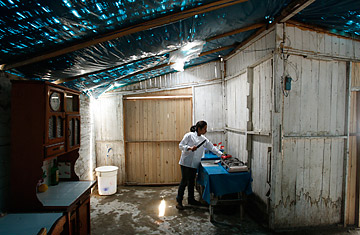
Yovani Palomino prepares food in the kitchen of her house in the shantytown of Pachacutec in Lima, Peru, December 18, 2010.
(2 of 2)
The students, needless to say, eat it up. Jessica Espinoza, 22, who is about to finish the program, says the rigorous schedule has been worth it. "I always wanted to be a chef, but could not afford it," she says. She has specialized in seafood and plans on traveling throughout Peru when she finishes the program to learn firsthand about regional cooking before trying to land a job at a top restaurant and, eventually, opening her own place. "We have been trained in everything, from cleaning to storage to preparing dishes taught by the masters," she says. "We need to take advantage of every minute the institute offers us."
Anthony Cruz, 20, started at the institute this year. He began cooking for his family when he was 13 after his mother got sick. "I was hooked from the start and when I heard about the institute I applied immediately. There is nothing else like this," he says. Cruz hopes to follow in the footsteps of two recent graduates who have received scholarships to study abroad, one in France, the other in Spain. "Peruvian food will be my specialty, but studying in Europe, learning techniques, is something that opens the field wider."
The gusto of the Pachacútec students has made a strong impression on visiting instructors. "They have an eagerness to learn that I have not seen in students in traditional culinary schools. They have an enormous desire to learn and are looking for new information. The future of our gastronomy depends on kids like these," says Natty Echeverría, a well-known local chef and professor at a top-end school who recently offered a guest lecture to the students. "The same day I was in Pachacútec I also offered a presentation at one of the best schools. I am sure that if I asked the kids in Pachacútec to make me a dinner they would prepare something that in taste and presentation would be better than students at the expensive culinary institutes, because they are committed and want this."
Acurio makes no bones about what he hopes all this enthusiasm will lead to. "We are developing a vanguard project that will train an army of chefs who will revolutionize this country," he says. "I see Peruvian cuisine as a way of transforming lives to help build a more just, prosperous and democratic society." But the number of new Peruvian chefs who measure up to international standards will, he believes, change the balance of power in the culinary world. Acurio, who learned the art of cooking in France, encourages study abroad, but believes that Peruvian cuisine and the Pachacútec Institute can eventually help reverse the trend, bringing foreign students to Peru to study.
"When I wanted to be a chef I had to leave Peru because there were no culinary schools," says Acurio. "Today, we have around 50,000 people in institutes and students from throughout Latin America coming to Peru to study. In 25 to 30 years, Peru can be a reference point for anyone wanting to study gastronomy." He adds, "One of the tasks of Peruvian cooking right now is defining our potential as part of the dream of 'Peruvianizing' the world."
